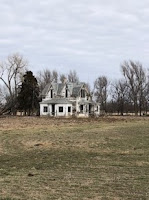 |
| Photo credit: L. Fenwick |
 |
| Photo credit: L. Fenwick |
Each decade brings more abandoned houses that were occupied during my lifetime. Farms still exist, but it is much different from the farming of my youth. Hugh equipment can move through a field in just a few hours, doing what would have taken my father a full day or more to cover the same ground. Consequently, farms are larger, and the number of farmers are fewer.
 |
| Photo credit: L. Fenwick |
Some of the family farms of my youth still exist, but they are few. Descendants of those farmers chose different careers away from the land, or gradually they chose to sell the land rather than divide it up among many descendants remaining. Sometimes the family line came to an end, and the estate was liquidated.
My husband and I moved back to my old family home in our retirement, but we do not farm the land. Instead, our land is farmed by another farming family. My brother had already sold the acreage he inherited before his death.
Once the houses pictured in this blog had families living in them, and it is more than likely that the generation that built the houses assumed that their heirs would be farming their land and living in the ancestral home for many generations.
The house first pictured is in Pratt County, although it is the closest of those pictured to our home. All of the rest are in Stafford County. We get our mail in town, and all of the images were taken on our way to get our mail, although we did go out of our way two miles to the east to photograph two of them. Even so, within just a few miles of our house, all of these family homes have been abandoned.
 |
| Photo credit: L. Fenwick |
In 1880, about the time Homesteader Isaac Werner staked his claim, the population of Stafford County, where he lived, was 4,755. Ten years later it had grown to 7,520, and by the turn of the century it was 9,829. In another ten years it had grown to 12,510. That year, 1910, was the peak year for Stafford County population. For three more decades, although the population declined, it remained in the 5 figures.
1950 was the first big drop of 15.9% to 8,816 population, followed in 1960 by the record drop of 20.2% to 5,943. While the percentage drops were smaller, the decline continued, until the 10.7% drop of 2000 brought the population to 4,437. The population has continued to decline to the most recent number of 4,178 estimate recorded for 2018.
There are other vacant houses close to our own that I did not photograph, homes that remain quite livable, but to find jobs, residents would probably need to commute to one of the surrounding small towns. Sometimes people with an urban background who may have dreamed of someday living on a farm buy country places. While there are successful transitions, there are also disappointments.
 |
| Photo credit: L. Fenwick |
That is not new. In Isaac Werner's time there were families drawn to the prairie by the free land and the idea of owning their own farms. Many did not stay long enough to mature their claims. Others stayed only long enough to mature their claim before they sold it and moved away.
Each generation leaves behind their own traces of the past.
1 comment:
Abandoned houses, broken dreams. This post makes me sad in a way. There is a Facebook group called "Old Saskatchewan" that people post pictures from times past. Old houses are a favourite. Everything from sod to log to three story mansions. The sod and log houses gave way to something better but the big and not so big frame houses abandoned because as you said farms got bigger and people moved away. Saskatchewan had over 130,000 farms 90 years ago and today we are down to 25,000. Makes for a lot of empty farm sites. And yes, every one hoped their family would carry on.
Post a Comment